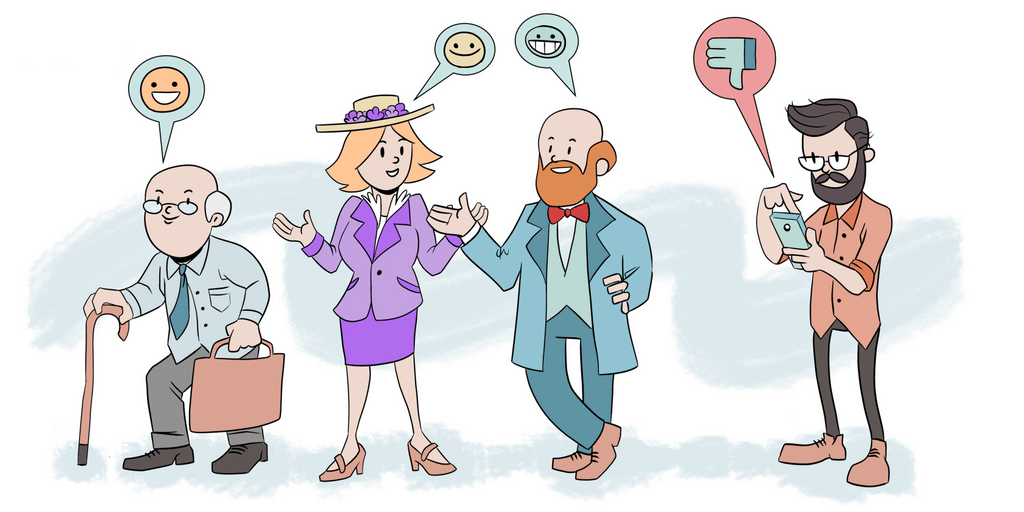Collecting customer feedback is important to succeeding as a business.
This customer data tells you how to improve your business. Plus, listening to customers is the first step in providing great customer experiences.
How vital is the latter? Consider this — over 51% of US consumers switched service providers in 2012 due to poor customer service experiences.
Next time you’re in a store, look around you. Now, imagine one out of two shoppers never setting foot in that store again. That’s quite a lot of lost sales opportunities.
What is the best way to prevent this customer exodus? Easy. You need to listen to customer comments.
What is Customer Feedback?
Let’s start with the basics. Namely, the definition of customer feedback.
Customer feedback is defined as information received from customers assessing their satisfaction with a business’ performance.
Rather than end on this academic abstraction, let’s illustrate it with an example of a retail business.
Imagine you own a carpet cleaning business. Clients hire your company to steam and freshen their carpets, upholstery, and anything else fibrous in their homes or offices.
Following so far?
Fortunately, you were a prudent fellow when you launched your business. So, once your cleaning service is completed, an email is fired off to your client, with a customer evaluation questions:
“How satisfied were you with our service today?”
“Was there anything we could have done differently?”
“How can we improve our service to meet your needs better in the future?”
These are fine customer feedback questions. They dig down to the roots that motivate responses and can potentially reveal ways to increase customer satisfaction.
But there’s another question lurking just behind the curtain of this customer experience survey. And that’s “Are you listening?”
Why You Should Care About Customer Feedback

For most people, the first instinct is to throw anything related to "customer feedback survey" into a spam folder. However, the research suggests you do otherwise.
Harvard Business Review conducted a study in which they surveyed one group of customers, and ignored a second. Here’s what they found:
“A year after the survey was conducted, the customers we surveyed were more than three times as likely to have opened new accounts, were less than half as likely to have defected, and were more profitable than the customers who hadn’t been surveyed.”
What’s more, surveyed customers continued to open new accounts at a faster rate and were less likely to abandon a business.
While the underlying implications for psychology are interesting, the real takeaway for us is that a simple customer feedback survey increases your company’s business.
Something like a toll-free hotline potentially provides clients with a great customer experience. They can vocalize both their concerns and compliments, and do so openly and honestly.
But there’s an even more fundamental reason to care about customer feedback.
Humanizing Your Brand With Customer Surveys
One of the biggest hurdles businesses have to face is humanizing their image. They’re not faceless machines, but may appear as such.
Customer engagement specialists at Rapide conducted a study in conjunction with YouGov on the way businesses are perceived by customers.
They found that 43% of surveyed customers don’t answer customer feedback questionnaires because they believe businesses don’t care.
Turns out, this is linked to an earlier, more startling, discovery: nine out of ten people don’t speak up even when receiving poor customer service.
Instead, these customers shrug their shoulders, bottle it up, and spill their frustrations at the dinner table with friends and family.
At a glance, it doesn’t seem to be a big deal. In fact, shouldn’t you be relieved that you don’t get negative customer comments?
But the loss of negative feedback means a loss in learning how you can improve your business. Not knowing how to increase customer satisfaction means more customers walking out the door and you powerless to stop them.
There’s a silver lining to this research. 81% of surveyed customers admitted they would leave a response if they knew they were being heard.
Once they see a business respond, their outlook on retail and the role of customer feedback may very well change.
Customer Feedback as a Way to Self-Improvement

“Know thyself” is not only a famous aphorism, but something every company should take as its internal motto.
After all, we can only improve by constantly scrutinizing our beliefs and actions — and the same applies to businesses.
But to a large degree, they can only know themselves by listening to customers. A customer feedback survey and customer feedback questions is a way for business to know what they’re doing right or wrong.
For instance, whether they should hire more staff or improve waiting time.
In essence, great customer feedback leads to better customer services, which leads to more customer loyalty.
A study by global management consulting firm Bain & Company found that improvements in customer service greatly impact customer loyalty:
“In groceries, a one point improvement in customer service satisfaction (on a scale of one to five) yielded a five percent increase in implied retention rates. And in consumer electronics, the same improvement yielded over a two percent increase in retention rates.”
A takeaway: Happy customers return to do business.
The Bain report adds, “The average repeat customer spent 67 percent more in months 31-36 of his or her shopping relationship than in months zero to-six.”
Customers who have a great customer experience are also more likely to recommend a business to their friends. Word-of-mouth marketing is one of the most effective forms of advertising the brand and gaining new customers.
Getting to Know Your Customers With Customer Feedback
Customer feedback lets employees understand not only their business but also who their customers are.
Otherwise, there’s a sense that one is removed from the final transaction, that customers exist as an abstract entity that either buys or doesn’t.
In this case, you will never understand why your customers leave for a competitor.
But when all departments have internalized customer feedback analysis, they start seeing clients as human beings. Customers have their wants, needs and desires, and it goes a long way to understand them.
Customer feedback isn’t just for addressing what’s wrong. It can also can be used to figure out what your business is doing right.
Positive feedback lets businesses know what to highlight as their strengths and how many resources to invest in a specific activity. As a result, feedback helps businesses become more cost-effective.
How to Collect Customer Feedback

Now that the importance of collecting customer feedback is fully covered, the question is not “Why?” but “How?”
As in, how do we go about creating a customer evaluation form in an effective manner?
To put it simply, the goal is to gather data about customer’s experiences from as many different points as possible.
To measure customer satisfaction, you need to create one homogenous customer feedback picture, or at least something that’s close to complete. The more data, the better you can improve your business.
Customer Feedback Surveys
The classic example of customer feedback is, of course, customer feedback surveys. We’ve all received them at one time or another after making a purchase.
They’re the obvious go-to tool for collecting customer feedback.
But there’s a right and wrong way to go about collecting survey data. All too often, businesses make the mistake of overstuffing their surveys with one question after another.
There’s a point of no return, after which customers decide they don’t have the time to answer your long list of questions.
Contrary to popular belief, people thrive within limitations. Ask Barry Schwartz and his book The Paradox of Choice: Why More Is Less — too many questions, and a customer feels overwhelmed.
Give customers guidance in the kind of feedback you’re looking for. Use signposts like, “Have you ever interacted with our social media pages?,” and then follow-up with, “Are there any social media channels you use that we don’t?”
Have a goal in mind when you formulate your questions.
You want a mixture of short surveys and long surveys. A single-flavored potpourri grows stale quickly.
And by short surveys, I do mean short — one or two questions, max.
Feature these questions prominently on your website so that customers eager to voice their opinions aren’t searching too long for the customer feedback survey.
If nothing else, ask yes-or-no questions. A whole lot of “No” and a whole lot of “Yes” speaks louder than any rambling essay on Yelp. The key is to
Then there’s a matter of motivating your customer to take your survey. Offer a reward for completing a customer questionnaire — such as a coupon, a discount, or a free tote bag.
It’s an inherent part of being a person in the 21st century to want to be compensated for your time. Reach a compromise that suits both sides.
Email are your primary channel for communicating with customers. Every time you complete a transaction with a client, send them an email request for feedback.
Email is an isolated communication channel. Nobody else can comment on a user’s report, so they tend to leave honest feedback, expressing their true feelings.
Your goal? Engage the customers who take the time to email their comments. Have a conversation. Don’t send an automated “Thank you!” reply. Nothing is more impersonal and algorithmically cold.
If a surveyed customers makes a few interesting observations, probe deeper. The most valuable question at your disposal is “What do you have in mind?”
Once you ask that, suddenly you’re not a heartless brand anymore. You’re a company that listens and engages, that treats customers like human beings and acts like one itself.
That’s how you increase customer satisfaction — by taking a personal approach to measuring customer feedback.
Online Review Sites

Review sites are a great place to gather customer feedback because they’re a kind of neutral territory where honesty reigns supreme.
Accenture found that 48% of US customers use third-party online sources such as official review sites. Additionally, 25% use customer reviews and comments on social media to measure the quality of product or services.
Monitor several of these sites such as Angie’s List and Yelp to stitch together a picture of your customers.
Create an account and respond to clients. This not only shows that you’re active but also moves the conversation forward so that you can address customer’s concerns.
Lastly, always thank customers for taking the time to discuss your business. A cordial online demeanor, even when dealing with angry customers, makes a positive impression.
If not to that specific angry customer, then at least to all others.
Social Media
Social media is your business’s frontline. It’s often the first place a customer will experience your presence outside of the store. And networks like Facebook are leaping pads where word-of-mouth advertising spreads.
Consider this: 43% of consumers are more likely to buy a product when learning about it on social media.
The basic rules for social media engagement are what we’ve already learned:
Engage in conversations.
Act like a human being.
Ask specific questions with a goal in mind.
Social media is a great place to share surveys and incentivize clients to partake in a customer feedback questionnaire.
Customer feedback is an invaluable resource for businesses that should not be taken lightly. Customers, taken collectively, inform businesses not only where and what they need to improve but also what they’re doing right.
The businesses that understand the value of customer feedback provide an invaluable resource in addition to their service — they listen. And being heard empowers both customers and businesses together.
Qminder understands the power of customer feedback, and encourages all its clients to listen to what their customers have to say. Good communication is key to building a successful business.
With a free 14-day Qminder trial, you can take your communication with clients to a new level.






